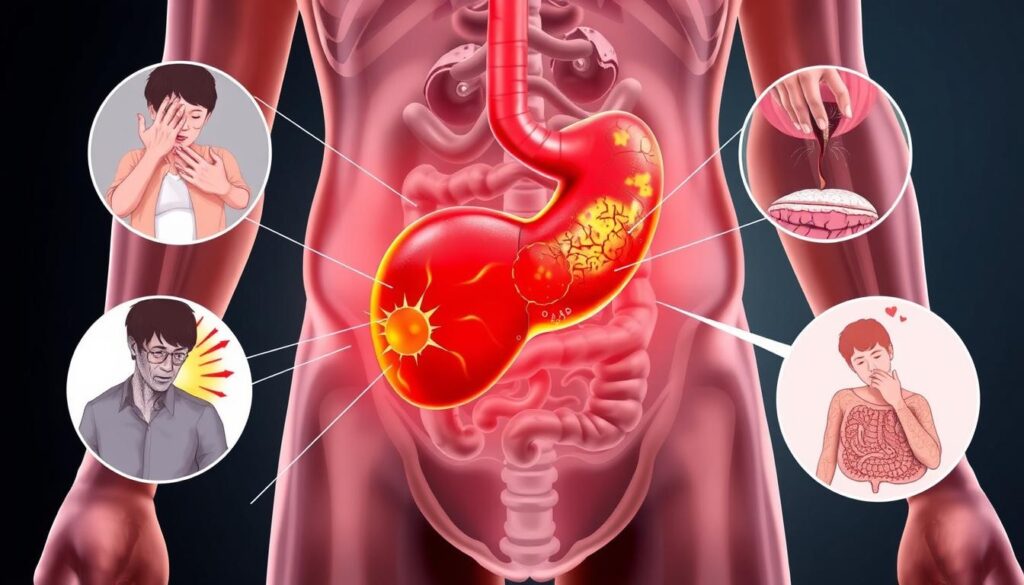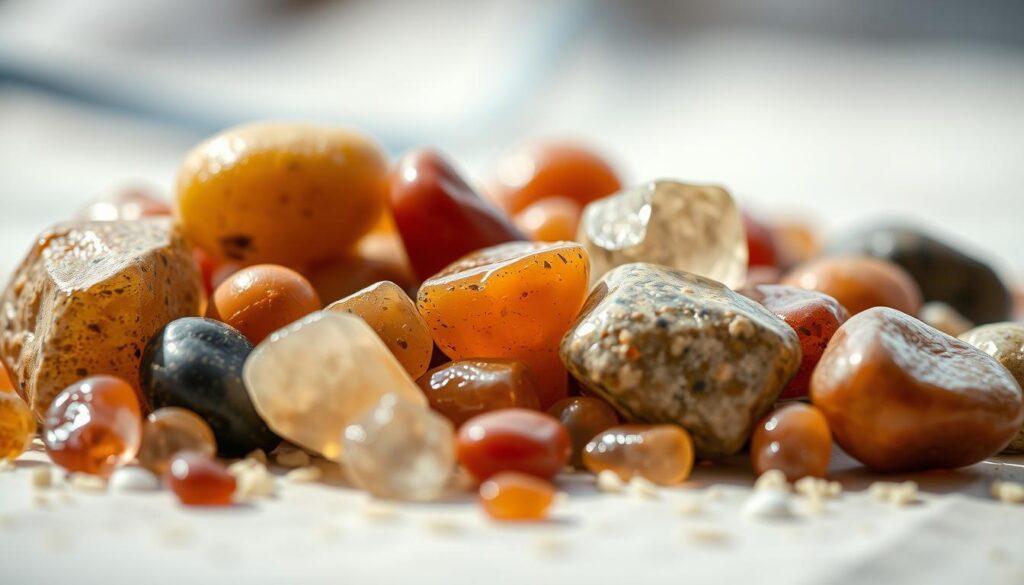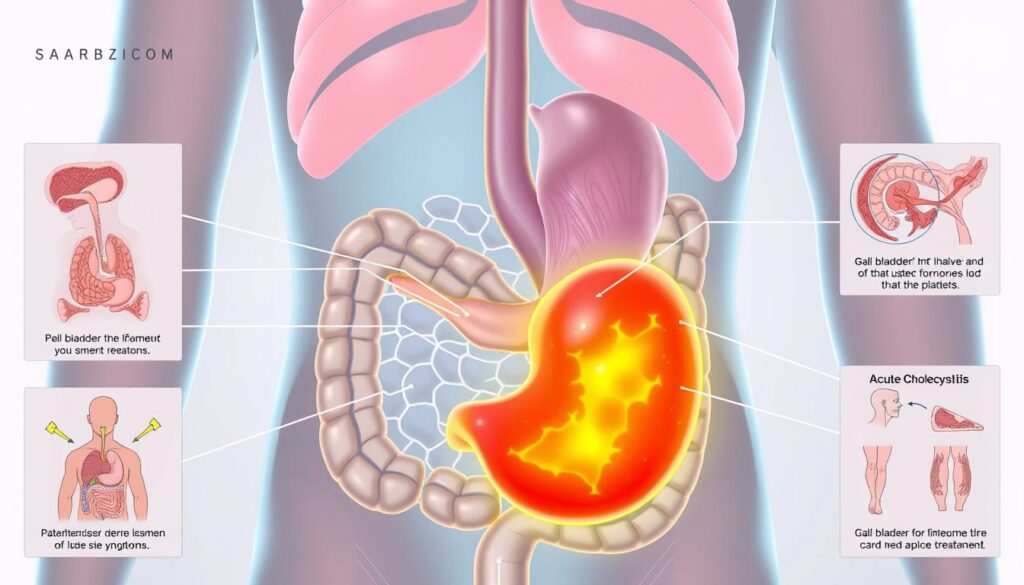Did you know that acute cholecystitis, a sudden inflammation of the gallbladder, affects about 1 in 7,000 people in the U.S. each year? This painful condition, often caused by gallstones, can lead to serious complications if left untreated. It’s important to understand the symptoms, risk factors, and treatment options to manage acute cholecystitis effectively.

Acute cholecystitis is a medical emergency that needs immediate attention. This guide will help you understand this gallbladder disorder. You’ll learn how to recognize symptoms, get the right care, and prevent it in the future.
Key Takeaways
- Acute cholecystitis is a sudden inflammation of the gallbladder, often caused by gallstones.
- Symptoms include severe abdominal pain, nausea, vomiting, and fever.
- Risk factors include obesity, rapid weight loss, and certain medical conditions.
- Diagnosis involves medical imaging and laboratory tests.
- Treatment options include medication, dietary changes, and in some cases, surgical removal of the gallbladder.
Understanding Acute Cholecystitis: A Comprehensive Overview
Acute cholecystitis is a sudden inflammation of the gallbladder. This small organ is under the liver and stores bile. The main symptom is biliary colic, a sharp pain in the upper right abdomen.
This pain can spread to the back or right shoulder. The main cause is gallstones, small hard deposits in the gallbladder. When a gallstone blocks the cystic duct, bile flow stops.
This leads to a buildup of bile and inflammation of the gallbladder. Acute cholecystitis is different from chronic cholecystitis. Chronic cholecystitis has recurring or ongoing inflammation.
Both share some symptoms, but the severity and duration differ. Acute cholecystitis is a serious condition that needs quick diagnosis and treatment.
“Acute cholecystitis is a medical emergency that requires prompt diagnosis and treatment to prevent potentially life-threatening complications.”
It’s important for healthcare providers to understand acute cholecystitis well. This includes its causes, symptoms, and how it progresses. We will explore these topics further in the next sections.
| Characteristic | Acute Cholecystitis | Chronic Cholecystitis |
|---|---|---|
| Onset | Sudden | Gradual |
| Duration | Short-term, lasting days to weeks | Long-term, with recurrent episodes |
| Severity | Severe, with potential complications | Milder, but with risk of complications |
| Treatment | Immediate medical intervention, often including surgery | Medication, dietary changes, and potentially surgery |
Common Signs and Symptoms of Gallbladder Inflammation
Acute cholecystitis, or inflammation of the gallbladder, shows symptoms that can start off mild but get worse if not treated. Knowing the main and secondary signs is key for quick diagnosis and treatment.
Primary Symptoms of Acute Cholecystitis
The main symptom is a dull pain in the upper right abdomen. This pain can spread to the back, shoulder, or chest. It often comes with nausea and vomiting. Also, a fever may show up, meaning there’s an infection.
Secondary Manifestations and Warning Signs
As it gets worse, people with acute cholecystitis might notice more symptoms. These include:
- Tenderness or guarding in the right upper quadrant of the abdomen
- Increased heart rate
- Decreased appetite and weight loss
- Yellowing of the skin and eyes (jaundice)
When Symptoms Require Emergency Care
Acute cholecystitis can sometimes cause serious problems like gallbladder perforation or gangrene. If you have severe, ongoing abdominal pain, keep vomiting, have a high fever, or signs of sepsis, get help right away.
Spotting early signs and getting quick treatment are vital for dealing with acute cholecystitis. By knowing the symptoms, you can take steps to protect your health.
Risk Factors and Contributing Conditions
Acute cholecystitis is the inflammation of the gallbladder. It can happen for many reasons. Knowing these factors helps us spot who’s at risk and how to prevent it.
Age is a big risk factor. As people get older, they’re more likely to get gallstones. This is a common cause of gallbladder inflammation. Other medical conditions like obesity, diabetes, and jaundice also raise the risk.
Women are more likely to get acute cholecystitis than men. Hormonal changes, especially during pregnancy and with birth control, can lead to gallstones. This can cause inflammation in the gallbladder.
Some lifestyle choices can also increase the risk. Being inactive, losing weight too fast, and eating a lot of fat and cholesterol can lead to gallstones. This, in turn, can cause inflammation in the gallbladder.
People who have had surgery in their abdomen, especially on the biliary system, are at higher risk. This is because surgery can mess with the gallbladder’s normal function and structure.
| Risk Factor | Description |
|---|---|
| Age | Increased risk with advancing age, as gallstones are more common in older individuals. |
| Gender | Women are more susceptible than men, due to hormonal factors and the use of oral contraceptives. |
| Obesity | Excess body weight is a significant risk factor for the development of gallstones and acute cholecystitis. |
| Diabetes | Individuals with diabetes have a higher risk of developing gallstones and gallbladder inflammation. |
| Jaundice | Elevated bilirubin levels, as seen in jaundice, can contribute to the formation of gallstones and acute cholecystitis. |
| Abdominal Surgery | Previous procedures involving the biliary system can disrupt the normal function of the gallbladder, increasing the risk of inflammation. |
By understanding and tackling these risk factors, we can lower our chances of getting acute cholecystitis. This helps us stay healthy and feel better overall.
The Role of Gallstones in Acute Cholecystitis
Gallstones often cause acute cholecystitis, a painful condition. It involves inflammation of the gallbladder. Knowing about gallstones and their role is key to managing and preventing this issue.
Types of Gallstones
Gallstones differ in composition and size. The most common types are:
- Cholesterol stones, mainly made of hardened cholesterol.
- Pigment stones, made of bilirubin, a byproduct of red blood cell breakdown.
How Gallstones Lead to Inflammation
A gallstone stuck in the bile duct or gallbladder blocks bile flow. This blockage causes the gallbladder to inflame. It leads to biliary colic and abdominal pain, symptoms of acute cholecystitis.
Acalculous Cholecystitis
Acute cholecystitis can also happen without gallstones, known as acalculous cholecystitis. This rare form is linked to critical illness, trauma, or other health issues that harm the gallbladder.
Understanding gallstones’ role in acute cholecystitis is vital. It helps doctors create better treatment plans. This improves patient care and outcomes.

Diagnostic Procedures and Tests
Getting a correct diagnosis for acute cholecystitis is key to good treatment. Doctors use many methods to check a patient’s health and find the cause. These steps include physical checks, talking to the patient, and some tests.
The first thing doctors do is a detailed check of the abdomen. They look for tenderness, swelling, or signs of inflammation. They might also do a Murphy’s sign test to check for pain in the right rib area during deep breaths.
Doctors also ask a lot of questions about the patient’s health history. They want to know about past gallbladder problems, symptoms, and any other health issues. This helps them understand if ultrasonography is needed.
Before making a diagnosis, doctors might do blood tests. These include a complete blood count (CBC) and liver function tests. These tests can show if there’s inflammation or other signs of acute cholecystitis.
| Diagnostic Test | Purpose | Findings in Acute Cholecystitis |
|---|---|---|
| Ultrasonography | Visualize the gallbladder and surrounding structures | Thickened gallbladder wall, gallstones, pericholecystic fluid, and decreased gallbladder distensibility |
| CT Scan | Provide detailed images of the abdomen | Gallbladder wall thickening, pericholecystic fluid, and evidence of gallstones |
| HIDA Scan | Evaluate gallbladder function and bile duct patency | Absent or delayed gallbladder filling, indicating cystic duct obstruction |
Using these tests and a full patient check, doctors can find out if someone has acute cholecystitis. This helps them choose the right treatment.
Medical Imaging and Laboratory Assessments
To diagnose acute cholecystitis, doctors use medical imaging and lab tests. These tools help confirm gallbladder inflammation and rule out other symptoms. This is crucial for accurate diagnosis.
Ultrasonography Findings
Ultrasonography is often the first test for acute cholecystitis. It’s non-invasive and uses sound waves to show the gallbladder’s details. Signs of acute cholecystitis include a thickened gallbladder wall and fluid around it, along with gallstones.
Blood Test Indicators
Doctors also check blood tests to understand the patient’s health. High white blood cell counts and liver enzyme increases suggest acute cholecystitis.
Additional Imaging Studies
If ultrasonography results are unclear, more tests might be needed. These include CT scans, MRI, and hepatobiliary scintigraphy. They offer detailed views of the gallbladder and surrounding areas.
| Diagnostic Test | Key Findings in Acute Cholecystitis |
|---|---|
| Ultrasonography | Gallbladder wall thickening, pericholecystic fluid, gallstones |
| Blood Tests | Elevated white blood cell count, increased liver enzymes and bilirubin |
| CT Scan | Gallbladder wall thickening, pericholecystic fluid, gallstones, complications |
| MRI | Gallbladder wall thickening, pericholecystic fluid, gallstones, biliary duct dilation |
| Hepatobiliary Scintigraphy | Decreased or absent gallbladder uptake of radiotracer |
By combining test results, doctors can accurately diagnose acute cholecystitis. They can also find any underlying conditions causing symptoms.
Treatment Options and Medical Interventions
Managing acute cholecystitis often involves a mix of treatments. This includes conservative care, medication, and sometimes surgery.
The first step is usually conservative management. It aims to ease symptoms and avoid serious problems. Doctors might use pain meds like NSAIDs to help with the pain.
Antibiotic therapy is also common. It’s used to fight off any bacterial infections that might be causing the problem. The type of antibiotic depends on how serious the case is and the patient’s health.
| Treatment Approach | Potential Benefits | Considerations |
|---|---|---|
| Conservative Management | Symptom relief Prevention of complications | May not address the underlying cause Temporary solution |
| Antibiotic Therapy | Treat bacterial infections Reduce inflammation | Careful selection based on patient factors Potential side effects |
| Surgical Intervention | Definitive treatment for cholecystectomy Prevent recurrence | Increased risk of complications Longer recovery time |
In severe or ongoing cases, surgical intervention might be needed. This usually means a cholecystectomy, or gallbladder removal. The choice between a laparoscopic or open surgery depends on the situation and the surgeon’s skill.
“Timely and appropriate treatment of acute cholecystitis is crucial to prevent serious complications and improve patient outcomes.”
Knowing about the different treatments helps patients and doctors create a plan that fits the patient’s needs. This way, everyone works together to find the best solution.
Surgical Management: Cholecystectomy
For those with acute cholecystitis, the main treatment is a cholecystectomy. This surgery removes the gallbladder, which stores and concentrates bile. It’s the top choice for treating gallbladder disease and can stop future attacks.
Laparoscopic vs. Open Surgery
There are two ways to do a cholecystectomy: laparoscopic and open surgery. Laparoscopic surgery, also known as “keyhole” surgery, is the most common. It uses small incisions and special tools to remove the gallbladder through a camera.
Open cholecystectomy needs a bigger cut in the abdomen. It’s used for harder cases or when the gallbladder is very inflamed or scarred.
Post-operative Recovery
Laparoscopic cholecystectomy patients usually have a shorter hospital stay and less pain. They can get back to normal in one to two weeks. Open surgery recovery takes longer, often four to six weeks.
Potential Complications
Cholecystectomy is usually safe, but there are risks. These include infection, bleeding, bile duct injury, and ongoing pain. It’s important to see a doctor regularly after surgery to catch any problems early.
| Laparoscopic Cholecystectomy | Open Cholecystectomy |
|---|---|
| Minimally invasive approach | Traditional open surgery |
| Smaller incisions | Larger incision in the abdomen |
| Shorter hospital stay | Longer hospital stay |
| Faster recovery time | Longer recovery time |
| Lower risk of complications | Higher risk of complications |
Prevention Strategies and Lifestyle Modifications
Keeping a healthy lifestyle is crucial to avoid gallbladder inflammation. Making smart choices can lower your risk of getting this condition. Here are some ways to protect your gallbladder health.
Dietary Considerations
Your diet greatly affects your gallbladder. Choose a diet that is balanced and low in fat. Focus on:
- Lean proteins, such as chicken, fish, and legumes
- Fruits and vegetables rich in fiber and antioxidants
- Whole grains instead of refined carbohydrates
- Healthy fats, like those found in avocados, nuts, and olive oil
Try to eat less of saturated and trans fats, and refined sugars. These can cause gallbladder problems and gallstones.
Maintaining a Healthy Weight
Being overweight, especially around the belly, raises the risk of gallbladder inflammation. Work on keeping a healthy BMI through a balanced diet and exercise. Slow, steady weight loss is best for your gallbladder.
Regular Physical Activity
Regular exercise is good for your gallbladder. Try activities like brisk walking, swimming, or low-impact aerobics for 30 minutes daily. This helps keep a healthy weight, improves digestion, and boosts overall health.
Staying Hydrated
Drinking enough water helps prevent gallbladder inflammation. It keeps bile flowing and lowers gallstone risk. Drink at least eight 8-ounce glasses of water a day. Drink more if you’re active or live in a hot place.
By following these tips and making lifestyle changes, you can protect your gallbladder. Remember, a healthy lifestyle is a journey. Small, lasting changes can greatly improve your health over time.
Long-term Outlook and Management
People who have had acute cholecystitis usually have a good outlook if they get the right treatment. But, managing this condition is not just about getting better. It’s also about keeping healthy and avoiding future problems.
One big worry for those who’ve had acute cholecystitis is getting it again. Regular check-ups with a doctor are key to watch for signs of gallbladder problems or new gallstones. These visits might include physical checks, scans, and blood tests to keep an eye on things.
If someone has had their gallbladder taken out, they might need to change their diet and lifestyle. This could mean eating fewer fatty and high-fiber foods. They might also need to exercise regularly to stay healthy and avoid gaining weight.
“Patients who have undergone cholecystectomy may need to work closely with their healthcare team to manage any gastrointestinal issues that may arise, such as diarrhea or bile reflux.”
For anyone with a history of acute cholecystitis, staying on top of their health is important. By going to regular check-ups, following any lifestyle advice, and telling their doctor about any symptoms, they can stay well and avoid future gallbladder issues.

Conclusion
In this guide, we’ve looked into acute cholecystitis, a condition where the gallbladder gets inflamed. We’ve covered the causes, risk factors, symptoms, and how to deal with it. This gives you a full picture of this common issue.
Getting a diagnosis early and treating it quickly is very important. If not, acute cholecystitis can get worse and cause serious problems. Knowing how to diagnose and treat it helps us on the path to recovery.
Keeping your gallbladder healthy is all about prevention. Eating right, staying active, and managing health issues can help a lot. Taking care of your health now can protect you from future problems.
FAQ
Q: What is acute cholecystitis?
A: Acute cholecystitis is a painful inflammation of the gallbladder. It’s usually caused by gallstones blocking the bile duct. This can lead to severe pain, nausea, vomiting, and more if not treated.
Q: What are the primary symptoms of acute cholecystitis?
A: The main symptoms include sudden, severe pain in the upper right abdomen. You might also feel nauseous, vomit, and have a fever.
Q: When should someone seek emergency medical care for acute cholecystitis?
A: Seek immediate help if you have severe, ongoing pain, a high fever, jaundice, or signs of sepsis.
Q: What are the risk factors for developing acute cholecystitis?
A: Risk factors include being overweight, losing weight quickly, being pregnant, older age, and certain health conditions. These include diabetes, cirrhosis, and inflammatory bowel disease.
Q: How do gallstones contribute to the development of acute cholecystitis?
A: Gallstones can block the bile duct, causing inflammation of the gallbladder. This leads to acute cholecystitis. Sometimes, it happens without gallstones, known as acalculous cholecystitis.
Q: What diagnostic tests are used to confirm acute cholecystitis?
A: Doctors use physical exams, patient history, blood tests, and imaging like ultrasonography. These help find inflammation, gallstones, and other issues.
Q: How is acute cholecystitis treated?
A: Treatment starts with antibiotics, pain meds, and IV fluids. Often, removing the gallbladder is recommended to prevent further problems.
Q: What are the potential complications of acute cholecystitis?
A: Untreated cases can lead to serious complications. These include gallbladder perforation, bile duct inflammation, and sepsis. These can be deadly if not treated quickly.
Q: How can acute cholecystitis be prevented?
A: Preventing it involves maintaining a healthy weight, eating well, and managing health conditions. Regular health check-ups can also help catch gallbladder issues early.
